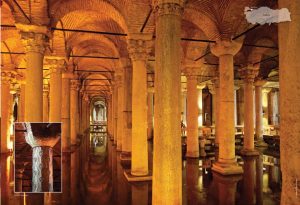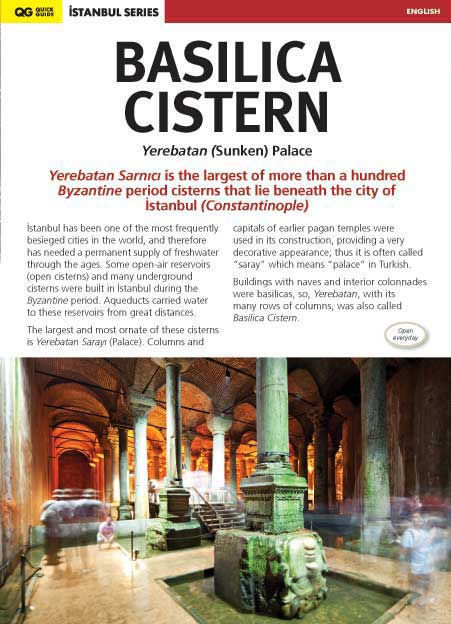Basilica Cistern
About Basilica Cistern – Yerebatan Sarnıcı (Sunken) Palace Pamphlet
A user friendly and informative Pamphlet with illustrations and plans about Basilica Cistern. Its content is very easy to understand. In addition to general information about the Cistern – Yerebatan Sarnıcı (Sunken) Palace in Istanbul, Turkey. A general plan of the surrounding areas will help the reader to get oriented to the Sultanahmet neighborhood. This Pamphlet type guide is also perfect for cruise ship passengers on their shore excursions.
Buy Now Basilica Cistern (Yerebatan Sarnıcı) Pamphlet
ISBN 9786058762459 Basilica Cistern (English, Turkish)
Available at Museum Shops in Turkey
Basilica Cistern (Yerebatan Sarnıcı)
The Basilica Cistern, also known as the “Yerebatan Sarnıcı” in Turkish, is a famous historical site located in Istanbul, Turkey. It is an ancient underground water storage system that dates back to the Byzantine period.
Here are some key points about the Cistern:
- Historical Background: The Cistern “Yerebatan Sarnıcı” was built during the reign of Byzantine Emperor Justinian I in the 6th century. It was constructed to provide a reliable water supply for the Great Palace of Constantinople (now Istanbul) and nearby buildings.
 Architecture and Design: The cistern is a vast underground structure that could hold up to 80,000 cubic meters (about 21 million gallons) of water. It is supported by a forest of 336 marble columns, each about 9 meters (30 feet) tall, arranged in 12 rows of 28 columns. The columns were sourced from various older structures, and their diverse designs and styles reflect the recycling of materials.
Architecture and Design: The cistern is a vast underground structure that could hold up to 80,000 cubic meters (about 21 million gallons) of water. It is supported by a forest of 336 marble columns, each about 9 meters (30 feet) tall, arranged in 12 rows of 28 columns. The columns were sourced from various older structures, and their diverse designs and styles reflect the recycling of materials.- Water Source: The water for the cistern came from various sources, including the Belgrade Forest located miles away from the city. An aqueduct system transported the water to the cistern, where it was stored for use during times of water shortages or sieges.
- Atmosphere and Ambiance: The Cistern has a unique and somewhat mysterious atmosphere. Visitors can walk along raised wooden platforms that allow them to traverse the water-filled cistern and explore the dimly lit space. The calm waters, the reflections of the columns, and the atmospheric lighting contribute to the site’s otherworldly feel.
- Medusa Heads: One of the intriguing features of the cistern is the presence of two Medusa heads, which are large marble sculptures used as column bases. The origin of these sculptures and their placement in the cistern remains a subject of debate and mystery.
 Tourist Attraction: Today, the Cistern is a popular tourist attraction in Istanbul. It provides visitors with a glimpse into the city’s rich history and architectural heritage. The site’s popularity has also been boosted by its appearance in various movies, documentaries, and novels.
Tourist Attraction: Today, the Cistern is a popular tourist attraction in Istanbul. It provides visitors with a glimpse into the city’s rich history and architectural heritage. The site’s popularity has also been boosted by its appearance in various movies, documentaries, and novels.- Restoration and Maintenance: Over the centuries, the cistern underwent several restorations and repairs. In the mid-20th century, a comprehensive restoration project was carried out to preserve and showcase the cistern’s historical and architectural significance.
Yerebatan Sarnıcı is a fascinating example of Byzantine engineering and architecture. It offers visitors a chance to step back in time and explore an underground marvel that has played a vital role in Istanbul’s history.








